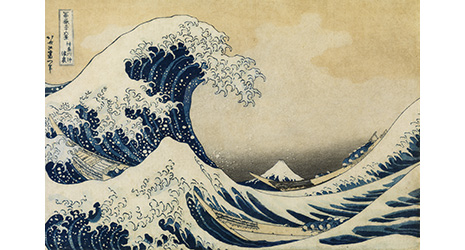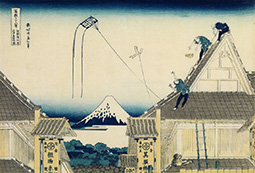January 2023
- English
- 日本語
Mt. Fuji as Depicted by Hokusai

Kanagawa-oki Nami Ura (Under the Wave off Kanagawa), from the series Fugaku Sanjurokkei (Thirty-six Views of Mount Fuji), by Katsushika Hokusai (Collection of the Sumida Hokusai Museum) 
Gaifu Kaisei (A Mild Breeze on a Fine Day), from the series Fugaku Sanjurokkei (Thirty-six Views of Mount Fuji), by Katsushika Hokusai (Collection of the Sumida Hokusai Museum)

Toryu no Fuji (Fuji and Ascending Dragon), from Fugaku Hyakkei (One Hundred Views of Mount Fuji), Vol. 2, by Katsushika Hokusai (Collection of the Sumida Hokusai Museum) 
Edo Surugacho Mitsui Mise Ryaku Zu (The Mitsui Shop at Surugachō in Edo), from the series Fugaku Sanjurokkei (Thirty-six Views of Mount Fuji), by Katsushika Hokusai (Collection of the Sumida Hokusai Museum)

The most famous work of Japanese art around the world is surely Under the Wave off Kanagawa from Thirty-six Views of Mount Fuji by Katsushika Hokusai (1760–1849). Hokusai was fond of Mt. Fuji and frequently used it as a motif in his work.

Katsushika Hokusai is well known around the world for his ukiyo-e* prints featuring Mt. Fuji. His best-known works depicting the mountain are those in the Thirty-six Views of Mount Fuji series that he created when in his 70s. Hokusai released this series in which he strikingly depicted Mt. Fuji as part of a variety of landscapes in around 1831.** Just as with serialized comics today, a series could end mid-way if it did not prove popular, so we can assume that the series was extremely popular at the time from the fact that Hokusai depicted the mountain 46 times in the end despite the series being called the “Thirty-six Views.” Partly accounting for the works’ success was the fact that Fuji-ko*** mountain worship was popular among ordinary people when they were published, but the main reason was undoubtedly Hokusai’s immense popularity and skill as an artist.
Okuda Atsuko, Chief Curator at the Sumida Hokusai Museum****, says that “at more than 70 years old and with his achievements and confidence as an artist, Hokusai seems to have taken on the challenge of creating various compositions with a desire to present his own Mt. Fuji. This I think explains why they were such a hit at the time and why they are still loved even today.”

The Sumida Hokusai Museum is located in modern-day Sumida City in Tokyo where Hokusai was born and lived for almost his entire life, and where he created many masterpieces.
In Under the Wave off Kanagawa, an especially famous print in the Thirty-six Views of Mount Fuji series and popularly known internationally as The Great Wave, Mt. Fuji stands quietly in the distance behind a large wave and a small boat being tossed about. It is considered a masterpiece of art around the world.

Okuda says of The Great Wave, “Mt. Fuji is depicted as a small feature in the scene, and the contrast between the movement of the powerful great wave and the mountain standing still is captured beautifully. Even though it appears small, Mt. Fuji isn’t a bit player in the scene. The composition is exquisite.”
After Thirty-six Views of Mount Fuji, Hokusai released One Hundred Views of Mount Fuji, a series of three books of woodblock prints comprising 102 prints in total, suggesting that Mt. Fuji was something special to him. He clearly had a strong desire to show Mt. Fuji from a variety of perspectives, including location, season, weather, and time. Perhaps this range of possibilities is what makes Mt. Fuji such a popular motif and source of creativity.
- * See Highlighting Japan December 2012, “Ukiyo-e”https://www.gov-online.go.jp/eng/publicity/book/hlj/html/201212/201212_06.html
- ** Ukiyo-e were sold in local book stores at the time, and because they were multicolored woodblock prints, many thousands were reprinted and sold if they became popular. They were priced the same as snacks at the time.
- *** See Highlighting Japan August 2019, “Mount Fuji, Object of Faith”https://www.gov-online.go.jp/eng/publicity/book/hlj/html/201908/201908_08_en.html
- **** See Highlighting Japan September 2019, “Hokusai Comes Home”https://www.gov-online.go.jp/eng/publicity/book/hlj/html/201909/201909_06_en.html

